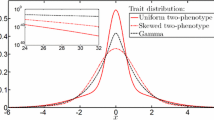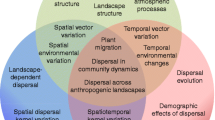Summary
Seed dispersal is important both to plant fitness and to plant population structure. We suggest that the tail of the seed dispersal curve is at least as important biologically as the modal portion of the curve, and we present a relatively simple, four-parameter model, based on diffusion principles, for the tail of the seed distribution. This model includes two types of qualitative behavior: algebraic tails (which tend to be longer and have greater ‘reach’) and exponential tails (which are shorter and have less ‘reach’). We have selected 68 data sets from the literature, each giving a seed shadow that could be categorized statistically as (1) exponential, (2) algebraic, (3) neither, or (4) both models fit adequately. Algebraic shapes for seed-shadow tails were common in this sample, and tail behavior was not generally specific to a particular dispersal mode. This result may suggest that algebraic tails are generally favored by selection and can be achieved by several means, but limitations of existing data sets and of statistical methodology preclude final judgement. Smaller complete samples of seed distances would provide a better basis for the analysis of tails than do the present form of data sets (consisting of counts of seeds in discrete distance categories).
Similar content being viewed by others
References
Alexander, R. R. (1969) Seedfall and establishment of Englemann spruce in clearcut openings: A case history.USDA Forestry Serv. Res. Pap. RM-53, 1–8.
Andersen, M. (1991) Mechanistic models for the seed shadows of wind dispersed plants.Am. Nat. 137, 476–97.
Antonovics, J. and Ellstrand, N. (1985) The fitness of dispersed progeny: experimental studies withAnthoxanthum odoratum.Genetic Differentiation and Dispersal in Plants (P. Jacquard, G. Hein, and J. Antonovics, eds), pp. 369–81. Springer-Verlag, Berlin, Germany.
Arnold, R. M. (1981) Population dynamics and seed dispersal ofChaenorrhinum minus on railroad cinder ballast.Am. Midl. Nat. 106, 80–91.
Augspurger, C. K. (1983) Seed dispersal of the tropical tree,Platypodium elegans, and the escape of its seedlings from fungal pathogens,J. Ecol. 71, 759–71.
Augspurger, C. K. and Franson, S. E. (1987) Wind dispersal of artificial fruits varying in mass, area, and morphology,Ecology 68, 27–42.
Augspurger, C. K. and Hogan, K. P. (1983) Wind dispersal of fruits with variable seed number in a tropical tree (Lonchocarpus pentaphyllus: Leguminosae),Am. J. Bot. 70, 1031–7.
Augspurger, C. K. and Kitajima, K. (1991) Experimental studies of seedling recruitment from contrasting seed distributions,Ecology, (in press).
Becker, R. A. and Chambers, J. M. (1984)S: An Interactive Environment for Data Analysis and Graphics. Wadsworth, Belmont, CA, USA.
Burbidge, A. H. and Whelan, R. J. (1982) Seed dispersal in a cycad,Macrozamia riedlei.Aust. J. Ecol. 7, 63–7.
Clark, C. R. (1987) Asymptotic properties of some multidimensional diffusions.Ann. Probab. 15, 985–1008.
Comins, H. N., Hamilton, W. D. and May, R. M. (1980) Evolutionarily stable dispersal strategies.J. Theor. Biol. 82, 205–30.
Crank, J., McFarlane, N. R., Newby, J. C., Paterson, G. D. and Pedley, J. B. (1981)Diffusion Processes in Environmental Systems. Macmillan, London, UK.
Cremer, K. W. (1966) Dissemination of seed fromEucalyptus regnans.Aust. Forestry 30, 33–7.
Dekkers, A. L. M., Einmahl, J. H. J. and de Haan, L. (1989) A moment estimator for the index of an extreme value distribution.Ann. Statist. 17, 1795–832.
Ford, R. H., Sharik, T. L., and Feret, P. P. (1983) Seed dispersal of the endangered Virginia round-leaf birch (Betula uber),Forestry Ecol. Mangt 6, 115–28.
Fox, P. A. (1984)The Post Mathemetical Subroutine library. Bell Laboratories, Murray Hill, NJ, USA.
Geritz, S. A. H., de Jong, T. J. and Klinkhamer, P. G. L. (1984) The efficacy of dispersal in relation to safe site area and seed production.Oecologia 62, 219–21.
Green, D. S. (1983) The efficacy of dispersal in relation to safe site density.Oecologia 56, 356–8.
Greene, D. F. (1989)The Aerodynamics and Dispersal of Plumed and Winged Seeds. Ph.D. Thesis, University of Calgary, USA.
Greene, D. F. and Johnson, E. A. (1989a) A model of wind dispersal of winged or plumed seeds.Ecology 702, 339–47.
Greene, D. F. and Johnson, E. A. (1989b) Particulate diffusion models and dispersal of seeds by wind.TREE 4, 191–2.
Hamilton, W. D. and May, R. M. (1977) Dispersal in stable habitats.Nature 269, 578–81.
Hallwachs, W. (1986) Agoutis (Dasyprocta punctata), the inheritors of guapinol (Hymenaea courbaril: Leguminosae).Frugivores and Seed Dispersal (A. Estrada and T. H. Fleming, eds), pp. 285–304. Junk, Dordrecht, Germany.
Horvitz, C. C. and Schemske, D. W. (1986) Seed dispersal and environmental heterogeneity in a neotropical herb: a model of population and patch dynamics.Frugivores and Seed Dispersal (A. Estrada and T. H. Fleming, eds), pp. 169–86. Junk, Dordrecht, Germany.
Howe, H. F. and Smallwood, J. (1982) Ecology of seed dispersal.Ann. Rev. Ecol. Syst. 13, 201–28.
Howe, H. F., Schupp, E. W. and Westley, L. C. (1985) Early consequences of seed dispersal for a neotropical tree (Virola surinamensis).Ecology 66, 781–91.
Isaac, L. A. (1930) Seed flight in the Douglas fir region.J. Forest. 28, 492–9.
Janzen, D. H., Miller, G. A., Hackforth-Jones, J., Pond, C. M., Hooper, K. and Janos, D. P. (1976) Two Costa Rican bat-generated seed shadows ofAndira inermis (Leguminosae).Ecology 57, 1168–75.
Koch, G. and Imrey, P. (1985)Analysis of Categorical Data. Les Presses de L'Université de Montréal, Montréal, Canada.
Kurtz, Thomas G. (1981)Approximation of Population Processes. SIAM, Philadelphia, USA.
Lamont, B. (1985) Dispersal of the winged fruits ofNuytsia floribunda (Loranthaceae).Aust. J. Ecol. 10, 187–93.
Lee, T. D. (1984). Effects of seed number per fruit on seed dispersal; inCassia fasciculata (Caesalpiniaceae).Bot. Gaz. 145, 136–9.
Levin, D. A. and Kerster, H. W. (1968) Local gene dispersal in phlox.Evolution 22, 130–9.
Levin, D. A. and Kerster, H. W. (1969) Density-dependent gene dispersal inLiatris.Am. Nat. 103, 61–74.
Levin, D. A. and Kerster, H. W. (1974) Gene flow in seed plants.Evol. Biol. 7, 139–220.
McCaughey, W. W. and Schmidt, W. C. (1987) Seed dispersal of Englemann Spruce in the intermountain west.Northwest Sci. 61, 1–6.
McEvoy, P. B. and Cox, C. S. (1987). Wind dispersal distances in dimorphic achenes of ragwort,Senecio jacobaea.Ecology 68, 2006–15.
Morse, D H. and Schmitt, J. (1985) Propagule size, dispersal ability, and seedling performances inAsclepias syriaca.Oecologia 67, 372–9.
Okubo, Akira (1980)Diffusion and Ecological Problems: Mathematical Models. Springer-Verlag, Berlin, Germany.
Okubo, Akira and Levin, Simon A. (1989) A theoretical framework for data analysis of wind dispersal of seeds and pollen.Ecology 70, 329–38.
Platt, W. J. (1976). The natural history of a fugitive prairie plant (Mirabilis hirsuta (Parsh) MacM).Oecologia 22, 399–405.
Platt, W. J. and Weis, I. M. (1977) Resource partitioning and competition within a guild of fugitive prairie plants.Am. Nat. 111, 479–513.
Platt, W. J. and Weis, I. M. (1985). An experimental study of competition among fugitive prairie plants.Ecology 66, 708–20.
Poole, A. L. and Cairns, D. (1940) Botanical aspects of ragwort (Senecio jacobaea L.) control.DSIR Bull. 82.
Rabinowitz, D. and Rapp, J. K. (1979) Dual dispersal modes in hairgrass,Agrostis hiemalis (Walt.) B.S.P. (Gramineae).Bull. Torrey Bot. Club 106, 32–6.
Rao, C. R. (1965)Linear Statistical Inference and Its Applications. Wiley, New York, USA.
Ricciardi, L. (1977)Diffusion Processes and Related Topics in Biology. Springer-Verlag, Berlin, Germany.
Roe, A. L. (1967) Seed dispersal in bumper spruce seed year,USDA Forestry Serv. Res. Pap. INT-39, 1–10.
Schaal, B. A. (1980) Measurement of gene flow inLupinus texensis.Nature 284, 450–1.
Silvertown, J. (1991) Dorothy's dilemma and the unification of plant population biology.TREE 6, 346–8.
Smith, R. L. (1987) Estimating tails of probability distributions.Ann. Statist. 15, 1174–207.
Stamp, N. E. and Lucas, J. R. (1983) Ecological correlates of explosive seed dispersal.Oecologia 59, 272–8.
Swaine, M. D. and Beer, T. (1977) Explosive seed dispersal inHura crepitans L. (Euphorbiaceae).New Phytol 78, 695–708.
Tamari, C. and Jacalne, D. V. (1984) Fruit dispersal of dipterocarps.Bull. Forestry Forestry Prod. Res. Inst. 325, 127–40.
Vickery, R. K., Phillips, D. R. and Wonsavage, P. R. (1986) Seed dispersal inMimulus guttatus by wind and deer.Am. Midl. Nat. 116, 206–8.
Webber, M. L. (1934) Fruit dispersal.Malay. Forester 3, 18–9.
Westelaken, I. L. and Maun, M. A. (1985) Spatial pattern and seed dispersal ofLithospermum carolinense in Lake Huron sand dunes.Can. J. Bot. 63, 125–32.
Willson, M. F. (1992) Dispersal mode, seed shadows, and colonization patterns.Vegetatio (in press).
Woodall, S. L. (1982). Seed dispersal inMelaleuca quinquenervia.Florida Sci. 45, 81–93.
Author information
Authors and Affiliations
Rights and permissions
About this article
Cite this article
Portnoy, S., Willson, M.F. Seed dispersal curves: Behavior of the tail of the distribution. Evol Ecol 7, 25–44 (1993). https://doi.org/10.1007/BF01237733
Issue Date:
DOI: https://doi.org/10.1007/BF01237733




